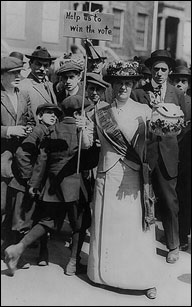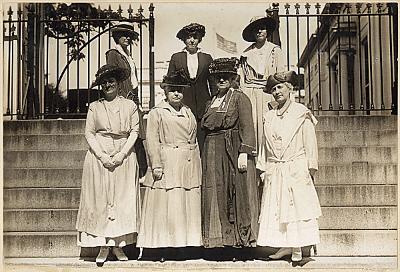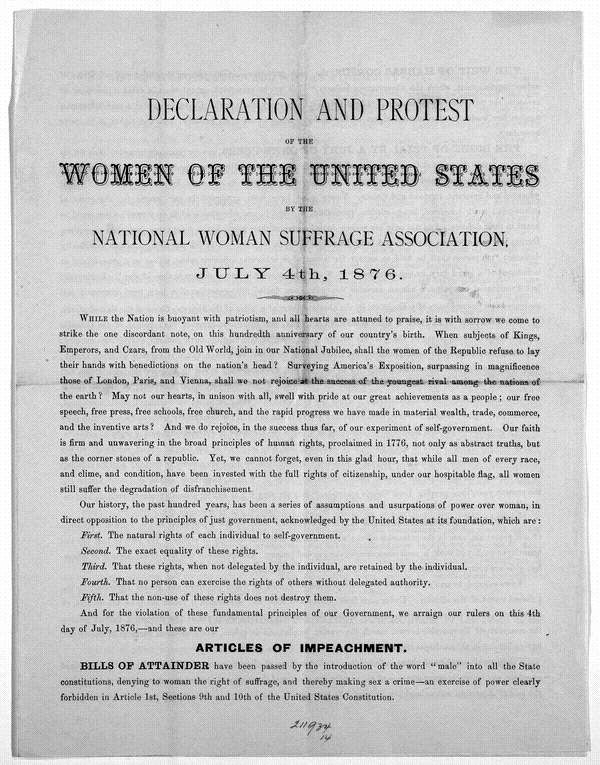
History of the Woman's Suffrage Movement
The women’s suffrage movement began in the mid-nineteenth century. Women began discussing the problems they faced in society and wanted to change their lives. The Civil War and World War I also had an effect upon the women’s suffrage movement. During both of these wars, women felt a new sense of independence. While their men were gone, women are allowed to work in factories and e active in their communities, to only return to "normal life" and be treated like nothing after the wars ended. Women from all over the country decided to join together, gain support, and advocate for change. Their ultimate goal was an amendment to the Constitution allowing them to vote, but within this goal lay many more. Each organization fought for a different goal, while working towards one central goal for all women: equality.
photo courtesy Library of Congress

Elizabeth Cady Stanton, in “Solitude of Self” wrote, “Secondly, if we consider her as a citizen, as a member of a great nation, she must have the same rights as all other members, according to the fundamental principles of our Government” (Buhle and Buhle 325-6). This is an example of the strong opinions of how women should be treated in American society. Through clever political and advertising tactics, these woman suffrage organizations gained support and membership throughout the United States. They published magazines and newspapers to get their word out and keep their members updated on the goals and progress of the organizations. Without women suffrage organizations and the dedication of these women, the Nineteenth Amendment would not have been passed in the timely fashion that it was under President Woodrow Wilson.
Throughout American history, women were overlooked and were not treated as equals. In 1848, Elizabeth Cady Stanton and other female leaders had the first women’s convention in Seneca Falls, New York, “a convention to discuss the social, civil, and religious condition and rights of woman…” (Buhle and Buhle 91). At this convention the Declaration of Sentiments was presented, which was a “claim to the universality of rights for an entire class of individuals” (Strom 54). The women began their declaration with a familiar phrase, yet it was a bit different than many knew it; “We hold these truths to be self-evident: that all men and women are created equal…” (Buhle and Buhle 94). Within these sentiments the women described the mistreatment they were subjected to and how it could be changed. Though this was a very radical view of the treatment of women and how it could be ratified, many women did agree with the Declaration of Sentiments. “The history of mankind is a history of repeated injuries and usurpations on the part of man toward woman, having in direct object the establishment of an absolute tyranny over her” (Buhle and Buhle 94), wrote the women. These women explained how men always ruled women since the beginning of time, and how now was the time to change society’s rules and views.
Though Seneca Falls in 1848 was the first women’s right convention, these views were not completely new. Sarah and Angelica Grimke had proposed a woman’s right to vote in 1837, and six Jefferson women in 1846 had petitioned the New York State constitutional convention for women’s suffrage. However, this Seneca Falls convention was just the first of many to come in the history of the women’s suffrage movement. In the next twelve years, ten local and national conventions would be held throughout the Northeast and Midwest (Strom 46). Two years later, in 1850, the first national women’s rights convention would be held in Massachusetts.
The formation of women’s suffrage organizations was not a new concept for most women. “Female benevolent societies were an important site of persuasive activity for early American women who wished to intervene in social and political matters” (Sharer 15). Prior to the women’s suffrage movement, women were also involved with benevolent societies, abolitionist organizations, and women’s clubs. Membership was popular in organizations such as the Female Association for the Relief of Women and Children in Reduced Circumstances, the New York Female Moral Reform Society, the Female Anti-Slavery Society, the General Federation of Women’s Clubs, and the Young Women’s Christian Association. While the benevolent societies and abolitionist organizations strengthened the female presence in political affairs, the women’s clubs provided cohesive networks that women could communicate through and use to form relationships.
1917 NAWSA delegation to meet with President Woodrow Wilson.
Image courtesy of U.S. National Archives and Records Administration.
Photograph created by the U.S. War Department. Photographer: Harris and Ewing. Modifications © Jone Lewis 2001.

In 1869, following the Civil War, female leaders had different views of where they wanted to take their suffrage organizations. Lucy Stone and Henry B. Blackwell were devoted to state-by-state amendment campaigns and formed the American Woman Suffrage Association (AWSA). Susan B. Anthony and Elizabeth Cady Stanton, on the other hand, supported a federal amendment campaign as well as state action. They founded the National Woman Suffrage Association (NWSA) in 1869. Over twenty years later, these two factions compromised and rejoined in 1890 to form the National American Woman Suffrage Association (NAWSA), the most successful woman’s suffrage organization. Besides NAWSA, there was also the Congressional Union for Woman Suffrage (CU), founded by Alice Paul in 1916. This group used “semi-militant tactics to demand that the federal amendment be passed” (Kraditor 30). They staged large scale protests and attacks upon the decisions of the president and the governing bodies of the United States. The Woman’s Party was a small group of women voters in full-suffrage states in the West, and this group joined with the Congressional Union to form the National Woman’s Party in 1912. Prior to 1910, the Women’s Christian Temperance Union (WCTU) and women’s club movement were more popular than NAWSA. (Strom 27). However, as women’s suffrage became more involved, NAWSA quickly gained members. In 1917 NAWSA had approximately 2,000,000 members across the nation (Kraditor 7). Only two other national women’s organizations supported suffrage: the Women’s Christian Temperance Union, and the National Association of Colored Women. NAWSA and other organizations utilized various advertising and recruiting tactics to gain more members.
The first national women’s rights convention was held in Massachusetts in 1850. The second convention was held in 1851 in Massachusetts and the third in 1852 in Syracuse. In February 1900, NAWSA celebrated its thirty-second annual suffrage convention. 1910 marked the first major woman suffrage parade in New York City. Over 400 women participated and it was very successful. Besides hosting their own parades and marches, women’s rights activists took part in other parades with floats and marchers (Graham 72). Lucy Stone, at the seventh National Strom Convention, stated, “Encouraged by the success of these seven years of effort, let us continue with unfailing fidelity to labor for the practical recognition of the great truth, that all human rights inhere in each human being” (Buhle & Buhle 158). To gain members and branches of organizations, women suffragists used the techniques of “flying squadrons.” Suffrage organizers would travel to certain regions to form new organizations or revitalize weak or inactive or inactive clubs (Graham 60). These flying squadrons also worked on increasing the size of already existing and active organizations throughout the nation. Organizations also held less formal meetings to solicit members and attract attention. Open-air, or street meetings, became more popular because they were inexpensive and very easily organized. It was very easy for one woman to stand on a box and speak about woman’s suffrage while another member of that organization would pass out literature about the topic at hand to gain support. Woman’s Suffrage Organizations used propaganda such as commercials and movies to show how important women were, and also used novelty items to gain a liking and support from the female communities. These items advertised women’s rights organizations – women bought calendars, label buttons, posters, and stamps. Another advertising tactic of these suffrage organizations was the publications that they distributed to their members.
Suffrage publications “enabled suffrage supporters to spread positive and encouraging words about their movement on the local, state, and national levels – an important ability given the largely negative coverage afforded the suffrage campaign in the popular press” (Sharer 108). In 1915, NAWSA developed its own suffrage publishing company. In 1916, the publishing company issued approximately five million fliers, and through a separate news service, sent press releases to six thousand newspapers all throughout the United States (Sharer 109). There were many different publications that reached out to suffragists and kept members updated on the issues of the suffrage organizations. Political magazines such as Woman Citizen, The Queen Bee, The Woman’s Exponent, Our Herald, The New Era, and The Woman’s Tribune informed the public of organizations’ plans of actions in the fight for woman’s suffrage. The Una and The Lily were “two of the earliest periodicals concerned about woman’s rights and edited by women” (Cooney 16). The Woman’s Journal was the most popular and well-known of all the publications. Published by NAWSA, it had over 5,000 subscribers and had readers in 59 countries by 1875. The Woman’s Journal “a leading force in the drive for equal suffrage both nationally and internationally while steering clear of more controversial reforms” (Cooney 29). Organizations such as the Congressional Union had weekly papers like The Suffragist, which was similar to other publications such as Saturday Visiter, Woman’s Advocate, Sibyl, and The Agitator.

The women's "Declaration of Sentiments" as presented to Congress.
Photo courtesy Library of Congress.
Also at this time during the women’s rights movement, Elizabeth Cady Stanton, Susan B. Anthony, and Matilda Joslyn Gage were compiling History of Woman Suffrage, which gave a first hand account of the woman’s suffrage movement as it happened. In 1902, NAWSA made efforts to establish circulating libraries, which included the History of Woman Suffrage and other works that gave insight on feminist theory and histories of the woman’s rights movement (Graham 49). Suffragists reached across class and race lines to reach out to women workers, immigrant women, and socialists. NAWSA grew ten-fold between 1906 and 1910 (Strom 205). Suffragists also took the messages of their organizations into schools in 1910 after Pauline Steinem conducted a study on female representation in history books. (Graham 50). These organizations contributed to the effort of placing women’s history, especially suffrage history, in classrooms and public libraries.
Washington was the first state to grant full suffrage to women. California, Kansas, Arizona, Oregon, Indiana, Michigan, Nebraska, and Rhode Island followed suit within the next few years. Through efforts of the National American Woman Suffrage Association, the Woman’s Party, and other organizations, President Woodrow Wilson gave an address endorsing woman suffrage in January of 1918. The Nineteenth Amendment, granting white women the right to vote, was passed in August of 1920. Women of all ages participated in the woman suffrage movement, because after all, “the suffrage movement provided many young women with an unaccustomed opportunity for work, travel, adventure, and camaraderie” (Graham 75). The suffrage movement allowed women to network and use their skills to fight for something they believed in and would benefit from. Suffragists such as Susan B. Anthony took part in the movement all the way into their eighties, while also being able to recruit young women to fight for their rights.
Works Cited
Buhle, Mari Jo., and Paul Buhle, ed. 2005. The Concise History of Woman Suffrage: Selections from History of Woman Suffrage. Chicago, Illinois: University of Chicago Press.
Cooney, Robert P.J. Jr. 2005. Winning the Vote: The Triumph of the American Woman Suffrage Movement. Santa Cruz, CA: American Graphic Press.
Graham, Sara Hunter. 1996. Woman Suffrage and the New Democracy. New Haven, CT: Yale University Press.
Kraditor, Aileen S. 1965. The Ideas of the Woman Suffrage Movement, 1890-1920. New York, New York: Columbia University Press.
Sharer, Wendy B. 2004. Voice of Vote. Carbondale: Southern Illinois University Press.
Strom, Sharon Hartman. 2003. Women’s Rights. Westport, Connecticut: Greenwood Press.
Analysis: "Oh Dear, What Can the Matter Be?"
Music and Collective Identity Within the Movement